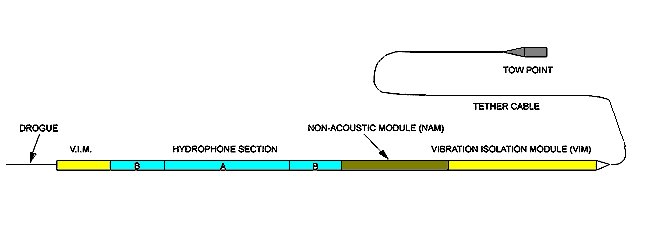



The TB-29 submarine thin-line towed array is a Commercial Off-The-Shelf version of the legacy TB-29 towed array. These arrays will be used for back-fit on Los Angeles (SSN-688 and SSN-688I) submarines and forward-fit on the Virginia (SSN-774) class. Compared with the legacy array, the TB-29 uses COTS telemetry to significantly reduce the unit cost while maintaining equivalent array performance. Technical and Operational Evaluations are scheduled for FY 2001. The first three arrays will be delivered to the Fleet in FY 2002.
The AN/BQQ-5E sonar with the TB-29 towed array and Combat Control System (CCS) Mk 2, known collectively as the QE-2 System, provides a functionally equivalent system for the Los Angeles (SSN-688) and Ohio (SSBN-726)-class submarines. Enhancements include increases in acoustic performance, improved combat control capabilities and replacement of obsolete equipment.
Towed array technology has advanced rapidly with longer, multiline systems that have an increasing number of sensors for submarine-based ASW. The TB-29 is longer than the thin-line TB-23 and has a sensor location system. It is now available on a few platforms and will be deployed on the Seawolf and the nuclear-powered attack submarine, new version (NSSN). It will be the operational submarine-towed array for the foreseeable future. Many existing Navy tow cable systems have single coaxial conductors, one to two kilometers in length, on which power, uplink data, and downlink data are multiplexed (e.g. SQR-19, TB-23, TB-29). These systems typically run at uplink data rates of less than 12 Mbit/s due to bandwidth limitations of the long coaxial cable.The Submarine Force is making significant, rapid improvements on our acoustic sensors and processing. In real-world exercises and operations, both the TB-29 towed array and Advanced Rapid COTs Insertion Sonar system (ARCI) demonstrate the ability to restore a remarkable acoustic advantage to U.S. submarines. Use of COTS in ARCI (and in a modified TB-29 array) results in substantially reduced costs with significantly improved processing capability. For example, each ARCI shipset costs about 20% of1/30 the price of its predecessor, yet improves processing power by an order of magnitude. Improvements in processing power allow the use of powerful new algorithms that resulted in much improved towed array detection ranges in testing to date.
Operational beam formers for towed arrays assume the array geometry to be straight and horizontal aft of the tow ship, whereas in reality there is always some deformation from this geometry. This is now measured by heading and depth sensors with varying degrees of success. Recently developed systems such as the TB-29 enable compensation in the beam former. A major limitation in current systems is that beam forming cannot be carried out when the ship is maneuvering, which can result in downtimes as great as 50 percent. CSS ADE and SFMPL currently utilizes a stiff stick model to estimate towed array position and heading. The newer tactical systems are equipped with sensors to accurately determine towed array position and heading. This information is more accurate than either the chain link or stiff stick models and should be used, when available, to optimize TMA solutions. Other tactical systems utilize the chain link model to more accurately predict towed array behavior.
OPEVAL for AN/BQQ-5E system with the TB-29 Array completed in FY 1998; this system will provide quantum improvements in long-range detection and localization for SSN 688 and SSBN 726 Class Submarines.
